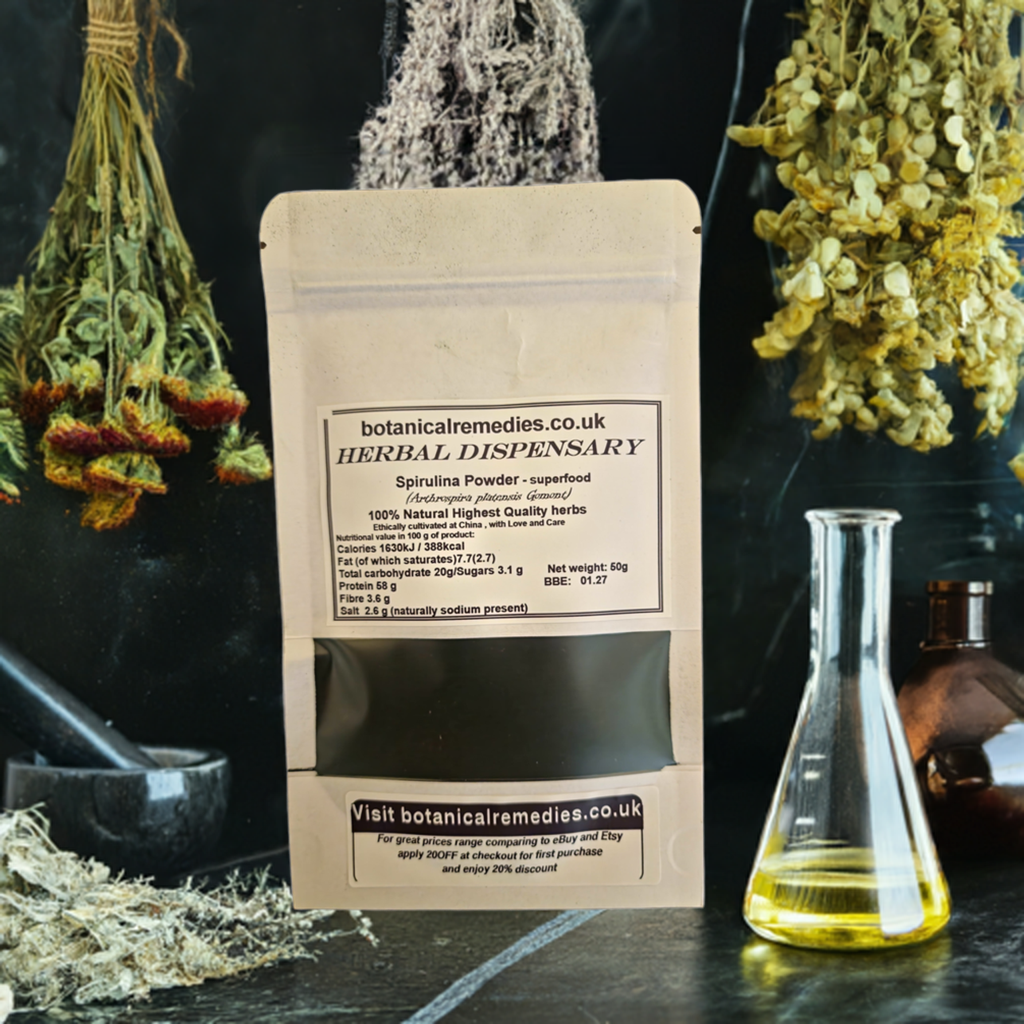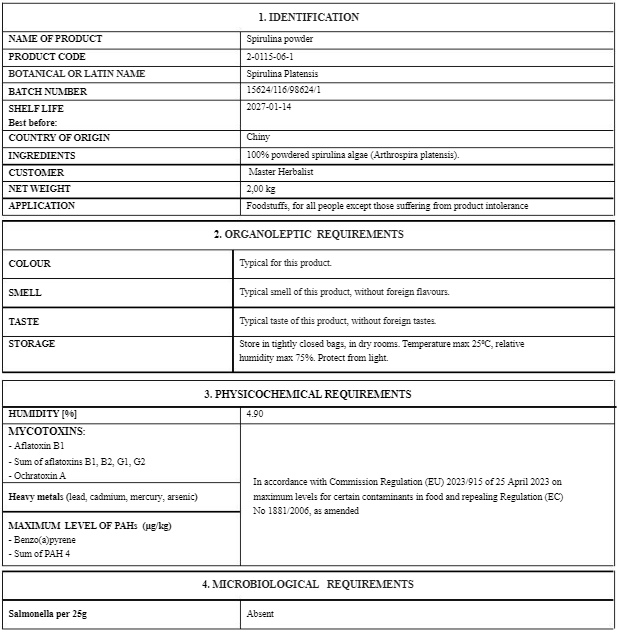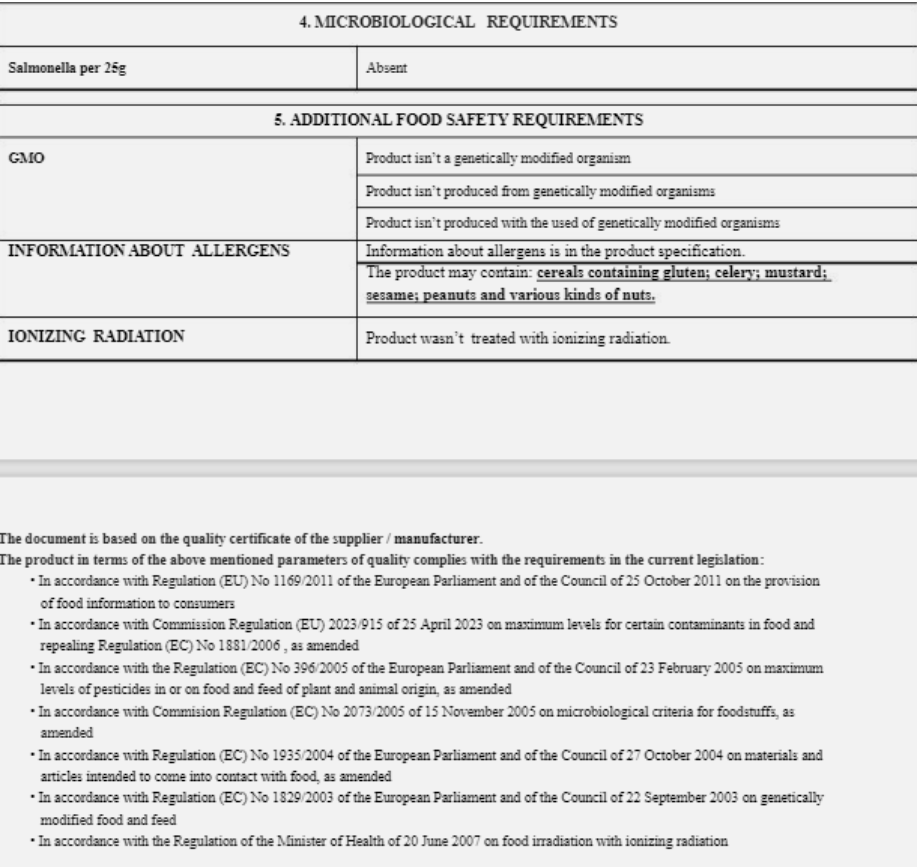Botanical remedies - Herbal Dispensary
Spirulina powder superfood (Arthrospira platensis Gomont) Lab-proven Quality and Purity
Spirulina powder superfood (Arthrospira platensis Gomont) Lab-proven Quality and Purity
Couldn't load pickup availability
Blue-Green Algae / Spirulina (Arthrospira platensis Gomont) also known as Blue Ground, Blue Run, Lan Zao.
Blue-green algae and spirulina are cyanobacteria. These one-celled organisms are thought to have converted the early atmosphere by producing gaseous oxygen as a by-product of photosynthesis. This process was said to be the “rusting of the Earth” and caused the Great Oxygenation Event that changed Earth forever, allowing new, more-complex life forms to develop.
Spirulina (Arthrospira platensis, A. maxima, A. fusiformis) is a naturally occurring blue-green algae that is commonly grown in a controlled environment. Blue-green algae (Aphanizomenon flos-aquae/AFA) is grown commercially in the wild.
Blue-green algae and spirulina are in fact, a phylum of bacteria and not true algae. Bacteria are single-celled organisms. True algae can be single celled or made up of multiple cells able to grow dozens of feet long. Algae are photosynthetic and are neither plant, animal or fungi. Blue-green algae and spirulina are single celled algae that have both algal and bacterial characteristics, being prokaryotes and capable of oxygenic photosynthesis. Prokaryotes are single-celled organisms that have neither a distinct nucleus with a membrane nor other specialized organelles. Bacteria and cyanobacteria are prokaryotes.
oth blue-green algae and spirulina are a complete source of protein. Spirulina is about 60-percent protein, containing all eight of the essential amino acids. Blue-green algae contains all 20 amino acids. Both are considered a superior source of protein even compared to other plant sources, such as legumes.
NASA has recommended spirulina be grown in space to feed the astronauts, declaring it 1000 times more nutritious than any other fruit or vegetable.
Spirulina has been a food source for the Aztecs and other Mesoamericans. After the sixteenth century, when many of their lakes, where the algae grew, were drained for agricultural and urban development, the food fell out of common usage.
Spirulina has been used successfully as an economical and highly-nutritious food source to feed the poor and promote better health in children. The World Health Organization recognizes spirulina as being safe and without risk for feeding children suffering from malnutrition.
Spirulina has the highest level of gamma-linolenic acid (GLA), or “good” fat, compared to other blue-green algae. GLA supports healthy brain and heart functioning. Spirulina is also generally considered a more-hygienic food source than many blue-green algae for its ability to thrive safely in more diverse environments, and it is often farmed in highly-controlled, safe conditions. An exception is Klamath Lake blue-green algae, which is grown wild and considered very safe, due to the pristine nature of its environment.
The constituent makeup of spirulina is said to match mother’s milk in its nutritional value and content ratios, making it, along with its simple cellular structure, extremely easy to digest and be absorbed by the body.
Research indicates that using blue-green algae with zinc twice a day can help counter environmental arsenic poisoning found in local contaminated water supplies.
Key Constituents: Chlorophyll, Protein, Amino Acids, Phycocyanin, Sulfated polysaccharides, Linoleic acid (GLA), Iron, Calcium, Manganese, Selenium, Iodine, Phosphorous, Chromium, Zinc, Fatty Acids, Magnesium, Copper, Beta-carotene, Vitamin A, Vitamin B1 (Thiamine) Vitamin B2 (Riboflavin), Vitamin B2 (Niacin), Vitamin B6 (Folic Acid), Vitamin B12 (Cyanocobalamin), Vitamin C, Vitamin D, Vitamin E, Vitamin K
Energy value: 1630kJ / 388kcal, Fat 7.7g; including saturated fatty acids 2.7g; Carbohydrates 20g; including sugars 3.1g; Fibre 3.6g; Protein 58g; Salt 2.6g (the salt content is solely due to naturally occurring sodium).
Flavors/Temps: Sweet, Salty, Slightly Bitter, Cooling to Cold
Suggested Use: It is recommended that Spirulina be taken at a gradual serving of ½ teaspoon a day building up to as much as 4 teaspoons daily (12 grams). Because Spirulina is so nutritionally rich then the body must get used to it. Initially symptoms of detoxification may be experienced.
Contraindications: Considered safe. Some people may experience nausea, diarrhea, or headaches.
Typical Ingredients: 100% pure Botanical, absolutely nothing added, dried Spirulina powder.
Vegetarian/Vegan Suitability: Suitable for Vegetarians and Vegans
Wild grown/Organic cultivation/Eco Cultivation/Cultivated: Cultivated
Country of origin: China
Packaging: All products are hand packed in paper resalable bags to ensure maximum freshness
Quality Assured
Share



Happy with my purchases 👌















